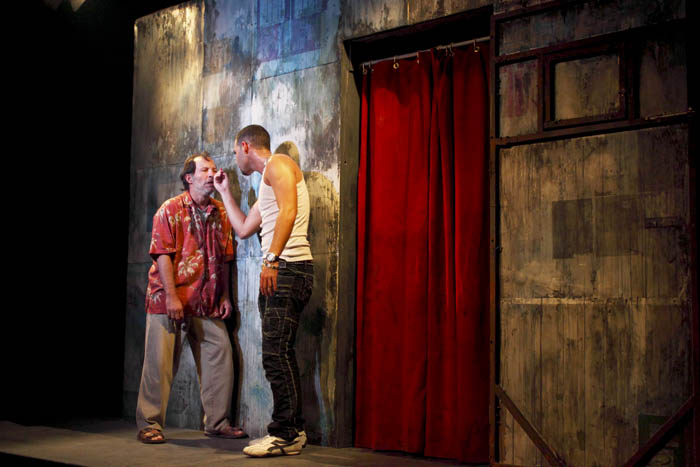If there is irrefutable proof of parallel universes, it is the amount of Havanas that coexist in Havana. Our capital has many faces which makes impossible to know them all, and thank God, because if you lose sleep over public Havana, what can I say of the hidden one? One wonders if that Havana the press sanctifies is the same literature demonizes, a city incomprehensible in its nuances, where things are not very much or so so, and where discourse and reality only have in common how amazing what they can be…
For example, the average Cuban can think it a lie, or at best exaggerated, that Havana outlined in Talc by Abel González Melo, a piece returned to the scene by Argos Teatro: four characters crushed by drugs, prostitution, the rotten beam of a dilapidated cinema, but above all, by a marginality they looked for, or found them.
The Carlos Celdran’s proposal invites to the Argos Teatro headquarters, a room favorable for culture but fatal for necks: its decks can be unbearable in a long show, but they leave in the audience a sense of voyeurism in the darkness, and anyway … what is the theater but to sniff in others’ intimacies?
Among the merits of the work stand out the minimalist set design, economy of resources and the credibility of the interpretations, no more hype than necessary, besides an evocative use of lights and music. For example, the transition to the past with Katyusha, musical icon of the Soviet era, is not without symbolism…
The cast, comprised by four actors and a dog, did shine: while José Luis Hidalgo won a Caricato award for his Álvaro el Cherna undoubtedly Waldo Franco with his Mashenka la Dura won the favor of the public, with a great impersonation of a low-life in phrases that “spiced” the piece.
Alexander Diaz plays Javi the Russian, a movie theater manager, pimp and seller of adulterated cocaine that pimps, impregnates and bludgeons Zuleidy la Guanty (Rachel Shepherd), a whore, maybe my only critic to the play because it repeats the cliché: please, not all prostitutes are disenchanted university students from Eastern Cuba…
Despite his boyish face, Gonzalez Melo likes to delve into the dirtiest corners of Havana nightlife. He already did with Chamaco, whose film version emphasized the view that sodomite in Cuban cinema is fashionable, and now he retakes that eschatological ride, but in a smaller area. I leave the harsher reviews to the critics. As a spectator, I think Talc is a good option to get into the Havana night, not only due to the performances, but because the plot engages, entertains and makes you think. Or as Celdran says, "it urges us, despite the shock or rejection that causes what it describes, to observe and recognize ourselves in it."
We would have to ask the author, but it seems to me that the title refers not only to cocaine or to the powder used to adulterate it. Maybe it’s a symbolic talc to mask an ugly reality that exists but we do not like, or deny, or do not want to see.
But do not be fooled by the theater, cinema and literature of XXI century Cuba: Havana nights have many shades and colors, and not all are dark. This Mecca of magical realism, any given night of the P8 passengers become sentimental and sing Marilú by Van Van. And then you enjoy the phenomenon and appreciates the musical taste of the driver with the same intensity that you attack his mother’s feelings because he didn’t open the doors in San Rafael and took you to the Parque de la India. Just because…










